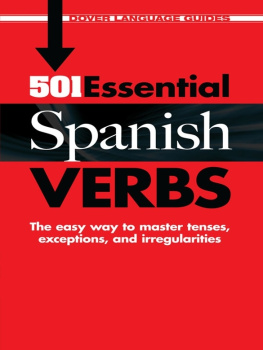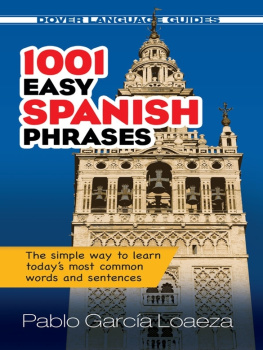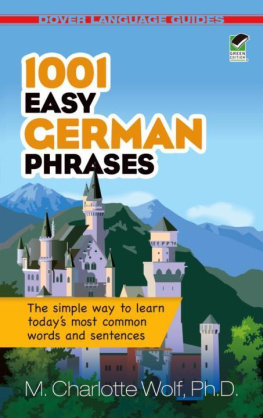EASY SPANISH PHRASE BOOKNEW EDITION Over 700 Phrases
for Everyday Use Pablo Garca Loaeza, Ph.D. DOVER PUBLICATIONS, INC. Mineola, New York Copyright Copyright 2013 by Dover Publications, Inc. Text copyright 2010 by Pablo Garca Loaeza, Ph.D. All rights reserved. Library of Congress Cataloging-in-Publication Data Loaeza, Pablo Garca, 1972 Easy Spanish phrase book : over 700 phrases for everyday use / Pablo Garca Loaeza. New ed. p. cm. cm.
First published by Dover Publications, Inc., in 2013, is a new selection of material from 1001 Easy Spanish Phrases, published in 2010 by Dover Publications, Inc. Includes index. eISBN-13: 978-0-486-31042-8 1. Spanish languageConversation and phrase booksEnglish. 2. I. Title. II. II.
Title: 1001 easy Spanish phrases. PC4121.L55 2013 468.3'421dc23 2012021714 Manufactured in the United States by Courier Corporation 49905701 www.doverpublications.com ContentsIntroduction This book will let you become familiar with a basic set of sentences, phrases, and words for simple everyday communication in Spanish. In particular, the would-be visitor to a Spanish-speaking country will find the tools necessary to deal with common situations related to travel abroad. The different sections cover topics such as transportation, accommodation, eating and drinking, as well as sightseeing, and shopping. There are also sections that cover a number of problems that may arise. Each section takes account of dialectic variation in Spanish by pointing out when a specific word is used in Spain (Sp.) or a particular Latin American country (Mex., Arg., etc.).
When appropriate, entries indicate whether the corresponding Spanish sentence is formal (for.) or informal (inf.). The book was designed to serve as a useful foundation rather than an exhaustive field manual. It is meant to be used for reference, study, and review. The more you practice the essential structures included here, the easier it will be for you to generate the questions and statements appropriate to your specific needs and circumstances. When you are communicating with someone, the other person is also trying to make sense of what you are saying and drawing information not just from your words, but also from context, tone of voice, and body language. When you need an answer, looking a person in the eye is generally more practical and more effective than reading from a book.
To facilitate acquisition, the material included in the different sections is presented in a logical sequence. As you go through the sentences, imagine yourself in the situations they suggest. In the Eating & Drinking section, for instance, you can go from finding a restaurant to asking for the check after ordering breakfast, lunch or dinner, and dessert. Since the material is not cumulative, book sections can be studied according to need or preference. You will note that certain structures, such as I want... , appear frequently throughout the book. , appear frequently throughout the book.
Besides being very handy, their repetition facilitates focusing on the many complementary words and phrases. Thus, you can learn to produce a large number of sentences and convey a wide range of information with minimum effort. Finally, while practice trumps theory, the Spanish Grammar Primer included here will help you make the most of the book. Besides vocabulary-building tips and verb conjugation tables, it contains information about nouns, adjectives, pronouns, and prepositions. However, many people will find Dovers Essential Spanish Grammar (ISBN 0-486-20780-3) helpful for mastering the subtleties of the Spanish language. A Note on Spanish Dialects As with English, there are many regional dialects of Spanish. A Note on Spanish Dialects As with English, there are many regional dialects of Spanish.
They may vary in pronunciation, vocabulary, and syntax but they are all mutually intelligible. For instance, in the Castile region of Spain a c before an e or an i sounds like th in English and the letter s is pronounced like sh. On the other hand, people in the south of Spain and in Latin America, generally make the letter c (before e or i), the letter s, and even the letter z all sound like the s in soup. Caribbean Spanish tends to drop a d between two vowels at the end of some words, as well as a final s so that cansados (tired, m. pl.) becomes cansao. Likewise, in many South American countries the word for cake is torta, whereas in Mexico it is pastel.
In Latin America a computer is called una computadora while in Spain it is referred to as un ordenador. Nevertheless, a Spaniard, a Mexican, a Chilean, and a Dominican can engage in conversation without impediment. When Spanish is learned as a second language the choice of dialect can depend on personal interest and circumstance. For example, someone traveling to Spain might prefer to become familiar with the Castilian dialect, while someone spending time in a Latin American country will pick up the local accent and lingo. The best investment for a beginner studying stateside is to practice a neutral kind of Spanish: all the syllables in a word should be pronounced clearly, using the standard word-stress rules (see the grammar section). Once you know the basic system, a little practice makes it easy to compensate for dialectical differences.
Remember also that the most useful words, such as por favor and gracias, are the same throughout the Spanish-speaking world. Unlike English-in which the same word may be written one way in Britain (colour, dialogue, emphasise, gaol) and another in the United States (color, dialog, emphasize, jail), all Spanish dialects use the same written standard. Phonetic Transcription The phonetic transcription of the Spanish words and phrases is provided as an aid to an approximately correct pronunciation in the absence of an audio model. However, the Spanish sound scheme is very regular and straightforward; with some practice you should be able to bypass the phonetic transcription in most instances. Other than the International Phonetic Alphabet, which employs a special set of characters, there is no standard for phonetic transcription. In order to facilitate reading, the phonetic transcription in this book follows the rules of English pronunciation and spelling as closely as possible.
For instance, vowels are short before a double consonant (as in dress); the letter c is hard before an a or an o (as in car), but soft before an e (as in celery); etc. The syllables that should be stressed are underlined. The phonetic transcription presented here corresponds to a neutral dialect of Spanish which, pronounced correctly, will be understood in any Spanish-speaking country. Phonetic transcription key:
| ah | A as in father and drama. |
| ay | long A as in stay, weigh, and train. |
| ch | as in chat, chess, and cheese. |
| ee | long E as in feet and eel. |
| eh, ess | short E as in pet, let, less, and rest. |
| ehr | sounds like air. |
| g | hard G as in gap, get, and geese. |
| h | H as in ham, heel, and hot. |
| I, i | long I as in the first person pronoun. |
| k | hard C as in cat, cot, and |
Next page












